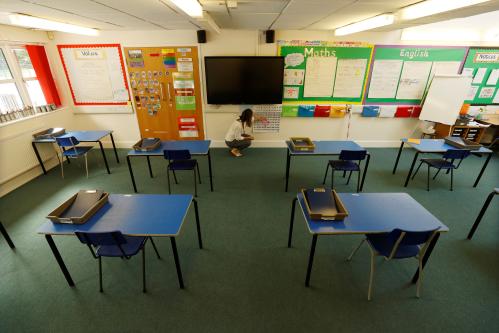This article is the third installment of a series entitled, “Federal aid for schools and COVID-19.”
In this series, we have explained why elementary and secondary education needs a large infusion of federal aid to protect students and promote economic recovery—and why Congress should not use existing formulas like Title I to distribute aid. One reason is that actual or perceived restrictions associated with existing programs could undermine states’ and school districts’ ability to spend federal aid flexibly, in turn undermining their ability to best meet varying and changing needs.
In this post, we discuss how Congress can instead choose a simple new formula to allocate a fiscal stabilization fund to states. Lawmakers will also need to decide how funds should be allocated within states to school districts; as prior stabilization packages have demonstrated, they need not use the same approach. We will discuss how funds should be allocated across school districts within states in the next installment to this series.
Congress should direct more aid to poorer states
Lawmakers should design a new formula that sends more money per pupil to states with higher child-poverty rates. Even absent a pandemic, more resources are needed to provide equitable educational opportunities for poor children. The current economic and public health crises only exacerbate this pattern by hitting the poor the hardest. And while we don’t know what the coming school year will hold, distance learning will almost certainly continue for some students or parts of the year. Poor children disproportionately face barriers to accessing distance learning, and public investments could help. Some districts may pursue hybrid approaches—involving some distance learning but also in-person instruction for some students, at some times, in new configurations. As districts explore what this would require, some are reporting the costs of meeting in person with appropriate public health measures in place are prohibitive. In-person school will be particularly important for the children of essential workers—many of whom have low wages—and need a place for their children to learn safely.
Despite the greater resource needs of poor students, per-pupil school spending is already lower in states with higher child-poverty rates. While much of the school finance policy discussion focuses on what states do, only the federal government can redistribute spending across state lines—and inequality in spending across states is indeed large. Figure 1 shows the strong pattern of lower school spending in higher-poverty states. Throughout this post, we define the poverty rate as the formula count for Title I (nearly entirely based on poor children) divided by the number of children aged 5-17. For example, current expenditure per-pupil in Arizona ($8,750) is roughly half the level in Massachusetts ($19,300).

All states are affected by the current crisis and the federal government needs to invest in all students. But higher-poverty states have less capacity to withstand these circumstances and need more federal support.
Title I formulas are progressive, but depend on factors other than child poverty
If Congress wants to distribute more aid to poor states, why not expand the main federal compensatory aid program, Title I, or distribute stabilization funds proportional to Title I allocations, as in the CARES Act ESSER Fund? As we have discussed, using Title I undermines local flexibility and creates confusion about the permissible use of funding.
But there’s another important reason: Title I allocations do depend on child poverty but also vary considerably for other reasons. Congress can use the number of poor children, rather than Title I allocations, as the key input into the formula determining how much stabilization aid each state receives to more effectively and transparently allocate additional aid to states with more poor children.
Figure 2 shows how allocations based on Title I would differ from alternative (hypothetical) approaches that use child poverty directly. Each panel shows the state child-poverty rate on the horizontal axis plotted against the (hypothetical) per-child aid a state would receive for each $10 billion of federal aid under different formulas for allocating fiscal stabilization funds to states. We are not recommending any of the specific approaches in Figure 2, but rather show these to illustrate how Title I allocations differ from per-poor-child allocations.

Panel A illustrates how Title I formulas direct more money per child to poorer states on average, while incorporating other factors as well. States’ shares of Title I and child poverty are not the same. For example, among states with similar child poverty rates (ranging from 11.6% to 12.3%) we see wide variance in allocations proportional to Title I: $104 per child in Colorado, $163 per child in Maryland, and $280 per child in Vermont. Title I formulas depart from straightforward per-poor-child grants for a number of reasons; we discuss only the key differences driving variation across states here.
First, Title I formulas incorporate state per-pupil expenditure (SPPE)—the average spending per pupil in the state in recent years, excluding federal funds. States that spend less get less Title I per eligible child; states that spend more get more. Panels B and C of Figure 2 show state-level allocations if $10 billion of federal aid were allocated based on child poverty, rather than Title I. Panel B includes an adjustment for SPPE (but no other components of the Title I formula), and Panel C makes no adjustments, relying solely on child poverty.
Comparing Panels A and B shows that the SPPE adjustment alone explains most of the difference between allocations based on Title I (Panel A) and per-poor-child allocations (Panel B). For example, the SPPE adjustment explains why Colorado receives less Title I funding per pupil than Maryland, despite having similar child-poverty rates; Colorado spent significantly less from state and local revenue than Maryland in previous years, so it had a lower SPPE.
Title I’s “small state minimum” drives the most noticeable variation—aside from intentional variation due to SPPE, so also present in Panel B—that is visible in Panel A. The small state minimum is why states including Vermont, Wyoming, North Dakota, and Alaska have such high per-child grants relative to their child-poverty rates under a Title-I based allocation (Panel A) compared to an allocation based on the number of poor-children adjusted for SPPE (Panel B).
These departures from using only child poverty in Title I are not random, but they are not necessarily desirable for stabilization purposes. For example, the SPPE adjustment is meant to address potential differences in the cost of education across states (assuming that states that spend a lot do so in part because prices, such as teacher salaries, are higher in some places than others). But because poorer states are lower spending on average (see Figure 1), the adjustment makes the allocation of aid less progressive. Small state minimums and hold harmless provisions are the result of years of political wrangling in a decades-old program.
A new fiscal stabilization fund does not need to—and should not—carry all this baggage with it.
How has Congress allocated stabilization aid in the past?
We discuss Title I because the CARES Act allocated the bulk of education aid proportional to Title I funding, presumably because Congress wanted to send more money to poorer places and the Title I program is associated with poverty. Other stabilization funds have allocated aid using simpler formulas that assign weights—in different configurations—to states’ shares of the total population, the population aged 5-24, and the population of poor children aged 5-17. Congress has combined stabilization funding for elementary and secondary and higher education; hence, the use of the population aged 5-24. These approaches are summarized in Table 1. The choice of what age group to consider (total population, population ages 5-17, or population aged 5-24) matters much less than the weight put on the number of poor children.
Table 1. How federal funds are awarded to states in federal fiscal stabilization funds
| Percent of funding distributed according to state share of … | |||||
| Population aged 5-24 | Poor Children aged 5-17 | Title I Allocation | Total Population | Sum | |
| May 12 Proposed HEROES Act | 61% | 39% | 0 | 0 | 100% |
|
2020 CARES Act Governor’s Fund |
60% | 40% | 0 | 0 | 100% |
|
2020 CARES Act Elementary and Secondary School Emergency Relief (ESSER) Fund |
0 | 0 | 100% | 0 | 100% |
| 2009 American Reinvestment and Recovery Act’s (ARRA) State Fiscal Stabilization Fund | 61% | 0 | 0 | 39% | 100% |
Figure 3 shows how much each state would get per $10 billion of federal aid using each of the (non-Title I) approaches in Table 1, plotted against its child-poverty rate. The fiscal stabilization package will need to be much larger than $10 billion to fill funding shortfalls; we use $10 billion to illustrate the differences across states.

Both the CARES Act GEER fund (Panel B) and the proposed HEROES fund (Panel C) allocate more aid per child to poorer places, without relying on Title I allocations. By contrast, the SFSF in ARRA distributed funds uniformly based solely on the state’s total population (39%) and its population age 5-24 (61%).
Like CARES ESSER (and unlike ARRA), the CARES GEER/HEROES approach directs more federal aid to poorer states. And in marked contrast to ESSER (and like ARRA), it promotes flexibility in how funds are used and avoids incorporating variation in funding based on other aspects of the Title I formulas that are arbitrary, irrelevant, or actively undesirable for stabilization purposes. The CARES GEER/HEROES approach therefore captures the best of both worlds. Because of the specific weights on child poverty and population in CARES GEER and HEROES, the grant amount per child increases less with state-level child-poverty rates with these funding mechanisms than under ESSER. (This is why the slope in Figures 3B and 3C is flatter than that in Figure 1A). If Congress wishes to make federal funds more progressive, it can increase the share of funds allocated based on child poverty rather than child population, while retaining the same basic structure and avoiding use of Title I.
What should the new formula look like?
We recommend a new simple formula similar to those used to allocate the CARES GEER fund and proposed fiscal stabilization fund in HEROES: a weighted function of the number of school-aged children and the number of poor school-aged children who live in the state. Congress needs to choose the weights, and the definition of “school-aged.”
In the legislation summarized in Table 1, the formulas use ages 5-24 for the population and 5-17 for the poor population. When one formula covers higher education as well as elementary and secondary, it makes sense to include young adults; in practice, however, the decision to include 18-24 year-olds in the population count makes little difference. The key question is how much weight to put on child poverty versus school-aged population. To illustrate this, we simulated the per-child allocations of aid using the GEER/HEROES approach—using states’ shares of population ages 5-24 and poor kids ages 5-17—to allocate aid, varying the weights put on each.
Figure 4 shows how Congress can make the allocation of aid more progressive by putting more weight on the share of poor children in this simple formula. States are ranked from highest to lowest poverty rate. The left panel plots the child-poverty rates, and the right panel plots the per-child allocation the state would receive as the weight put on the share of poor children varies from 0 to 100 (with the remaining weight on the population 5-25). The distribution of aid could be made more or less progressive by adjusting those weights, as the (moving) panel on the right shows. When the weight on child poverty is 0 (so all the weight is on population 5-24), the distribution of aid across states is essentially uniform; it only varies because some states have more 18-24 year-olds relative to the count of poor 5-17 year-olds. When 100% of the funds are allocated according to the number of poor children, poor states receive much larger per-child allocations than lower-poverty states.

Support states with simple, progressive aid
Congress should follow the example of the CARES Act GEER funds to direct money to states based on their share of the school-aged population and school-aged poor population, rather than based on Title I allocations, which is an imperfect proxy for the number of poor children. Because this approach incorporates child poverty in the formula used to allocate aid, this would be an improvement on the approach taken in ARRA’s SFSF. This framework allows for negotiation over how much more aid Congress wishes to direct to poorer states without incorporating aspects of Title I formulas that are ill-suited to the current situation.
Stabilization aid for education should be part of a broader package of federal aid to state and local governments, which is necessary to offset major budget shortfalls. Aid should also continue as long as the recession lasts; Congress should provide several years of stabilization aid for education. And including automatic stabilizers in other programs, for example, by tying the federal matching rate for Medicaid and the Children’s Health Insurance Program to state unemployment rates, would also help ensure federal support for states lasts long enough. This will improve the fiscal position of states and help protect all of the services funded by state governments, including education.
The authors did not receive financial support from any firm or person for this article or from any firm or person with a financial or political interest in this article. The authors are not currently officers, directors, or board members of any organization with a financial or political interest in this article.
The Brookings Institution is committed to quality, independence, and impact.
We are supported by a diverse array of funders. In line with our values and policies, each Brookings publication represents the sole views of its author(s).








